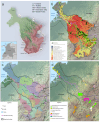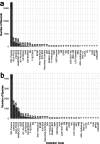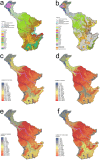The Tropical Andes Biodiversity Hotspot: A Comprehensive Dataset for the Mira-Mataje Binational Basins
- PMID: 39013892
- PMCID: PMC11252388
- DOI: 10.1038/s41597-024-03463-1
The Tropical Andes Biodiversity Hotspot: A Comprehensive Dataset for the Mira-Mataje Binational Basins
Abstract
We present a flora and fauna dataset for the Mira-Mataje binational basins. This is an area shared between southwestern Colombia and northwestern Ecuador, where both the Chocó and Tropical Andes biodiversity hotspots converge. We systematized data from 120 sources in the Darwin Core Archive (DwC-A) standard and geospatial vector data format for geographic information systems (GIS) (shapefiles). Sources included natural history museums, published literature, and citizen science repositories across 13 countries. The resulting database has 33,460 records from 6,821 species, of which 540 have been recorded as endemic, and 612 as threatened. The diversity represented in the dataset is equivalent to 10% of the total plant species and 26% of the total terrestrial vertebrate species in both hotspots. The dataset can be used to estimate and compare biodiversity patterns with environmental parameters and provide value to ecosystems, ecoregions, and protected areas. The dataset is a baseline for future assessments of biodiversity in the face of environmental degradation, climate change, and accelerated extinction processes.
© 2024. The Author(s).
Conflict of interest statement
The authors declare no competing interests.
Figures









References
-
- Sarkar S, Sánchez-Cordero V, Londoño MC, Fuller T. Systematic conservation assessment for the Mesoamerica, Chocó, and Tropical Andes biodiversity hotspots: a preliminary analysis. Biodiversity and Conservation. 2009;18:1793–1828. doi: 10.1007/s10531-008-9559-1. - DOI
-
- Cuesta, F., Peralvo, M. & Valarezo, N.Los Bosques Montanos de los Andes Tropicales. Una Evaluación Regional de su Estado de Conservación y de su Vulnerabilidad a Efectos del Cambio Climático (Programa Regional ECOBONA - INTERCOOPERATION, 2009).
-
- Londoño-Murcia MC, Sánchez-Cordero V. Distribución y conservación de especies amenazadas en Mesoamérica, Chocó y Andes tropicales. Revista Mexicana de Biodiversidad. 2011;82:926–950. doi: 10.22201/ib.20078706e.2011.3.1214. - DOI
Publication types
MeSH terms
Grants and funding
- 17-1707-152195-CSD/John D. and Catherine T. MacArthur Foundation (MacArthur Foundation)
- 17-1707-152195-CSD/John D. and Catherine T. MacArthur Foundation (MacArthur Foundation)
- 17-1707-152195-CSD/John D. and Catherine T. MacArthur Foundation (MacArthur Foundation)
- 17-1707-152195-CSD/John D. and Catherine T. MacArthur Foundation (MacArthur Foundation)
- 17-1707-152195-CSD/John D. and Catherine T. MacArthur Foundation (MacArthur Foundation)
- 17-1707-152195-CSD/John D. and Catherine T. MacArthur Foundation (MacArthur Foundation)
- 17-1707-152195-CSD/John D. and Catherine T. MacArthur Foundation (MacArthur Foundation)
- 17-1707-152195-CSD/John D. and Catherine T. MacArthur Foundation (MacArthur Foundation)
- 17-1707-152195-CSD/John D. and Catherine T. MacArthur Foundation (MacArthur Foundation)
- 17-1707-152195-CSD/John D. and Catherine T. MacArthur Foundation (MacArthur Foundation)
- 17-1707-152195-CSD/John D. and Catherine T. MacArthur Foundation (MacArthur Foundation)
- 17-1707-152195-CSD/John D. and Catherine T. MacArthur Foundation (MacArthur Foundation)
- 17-1707-152195-CSD/John D. and Catherine T. MacArthur Foundation (MacArthur Foundation)
- 17-1707-152195-CSD/John D. and Catherine T. MacArthur Foundation (MacArthur Foundation)
- 17-1707-152195-CSD/John D. and Catherine T. MacArthur Foundation (MacArthur Foundation)
- 17-1707-152195-CSD/John D. and Catherine T. MacArthur Foundation (MacArthur Foundation)
- 17-1707-152195-CSD/John D. and Catherine T. MacArthur Foundation (MacArthur Foundation)
- 17-1707-152195-CSD/John D. and Catherine T. MacArthur Foundation (MacArthur Foundation)
- 17-1707-152195-CSD/John D. and Catherine T. MacArthur Foundation (MacArthur Foundation)
- 17-1707-152195-CSD/John D. and Catherine T. MacArthur Foundation (MacArthur Foundation)
- 17-1707-152195-CSD/John D. and Catherine T. MacArthur Foundation (MacArthur Foundation)
- 17-1707-152195-CSD/John D. and Catherine T. MacArthur Foundation (MacArthur Foundation)
- 17-1707-152195-CSD/John D. and Catherine T. MacArthur Foundation (MacArthur Foundation)
- 17-1707-152195-CSD/American Institute for Contemporary German Studies (American Institute for Contemporary German Studies at The Johns Hopkins University, Inc.)
- 17-1707-152195-CSD/John D. and Catherine T. MacArthur Foundation (MacArthur Foundation)
- 17-1707-152195-CSD/John D. and Catherine T. MacArthur Foundation (MacArthur Foundation)
- 17-1707-152195-CSD/John D. and Catherine T. MacArthur Foundation (MacArthur Foundation)
- 17-1707-152195-CSD/John D. and Catherine T. MacArthur Foundation (MacArthur Foundation)
- 17-1707-152195-CSD/John D. and Catherine T. MacArthur Foundation (MacArthur Foundation)
- 17-1707-152195-CSD/John D. and Catherine T. MacArthur Foundation (MacArthur Foundation)
- 17-1707-152195-CSD/John D. and Catherine T. MacArthur Foundation (MacArthur Foundation)
- 17-1707-152195-CSD/John D. and Catherine T. MacArthur Foundation (MacArthur Foundation)
- 17-1707-152195-CSD/John D. and Catherine T. MacArthur Foundation (MacArthur Foundation)
LinkOut - more resources
Full Text Sources

